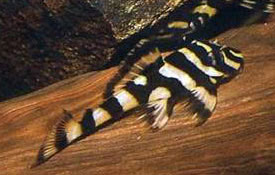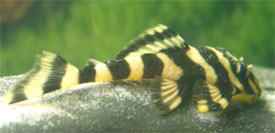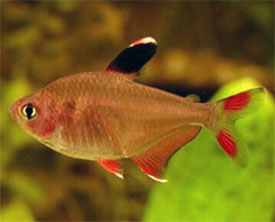
 Magyarul / Hungarian
Magyarul / Hungarian




- Scientific name: Dekeyseria brachyura
- Synonyms: Ancistrus brachyurus, Peckoltia brachyura, Zonancistrus brachyurus, Peckoltia pulcher
- Common name: Butterfly Pleco, L-168 Catfish
- Group: Catfishes
- Habitat: South America; Brazil
- Size: 14 cm
- Biotope: Flowing streams and tributaries of Rio Negro.
- Social behavior: Peaceful. Males will incessantly flare and chase, but no harm will result. Keep with similar-sized peaceful community fish.
- Diet: Omnivorous; An algae-eating pleco that needs constant access to vegetable matter, but will also eat meaty foods.
- Breeding: Very hard
- Tank: Minimum 100 litres
- Population: 2-3 fisheh for 100 litres
- Decoration: Prefers a spacious well filtered tank with hiding places, such as flat, rounded rocks and pieces of wood. These plecos usually don't harm live plants if they're fed properly.
- Temperature: 25-28 °C
- pH: 5.6-7
- Hardness: 2-12NK°
- Lifespan: 5-8 years
Description: This catfish is a master of disguise. It can change colouration, chameleon-style, quickly. If kept on a black or very dark substrate is will go almost black. Kept on a lighter substrate it will show a pretty striped pattern during the day. Another reason for misidentification of this fish is that its night-time colouration is totally different from that it has during the day. This species can be found in many hobbyist books under its old name of Peckoltia pulcher.
Males develop noticeably larger odontodes on the snout, while mature females are broader in the mid-section than males. Has been bred in captivity. Cave spawners by nature, they will require tight fitting, preferrably rectangular caves. Use soft, acidic water, and do a large water change with cool water to simulate the rainy season. The eggs are laid within a cave selected by the male. He tends them until they hatch, fanning them with his fins and defending against intruders. The eggs are hatch in 7-10 days. The male will force the fry to stay inside the cave until they are fully formed. Small, daily water changes are also required, as the fry are very sensitive to water quality.






















































